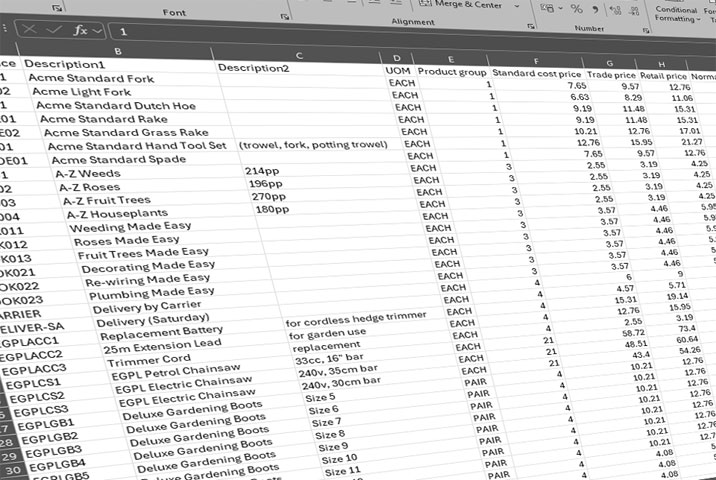Major Enhancements Released 10th March 2025
We are pleased to announce the release of a significant update to the function Import Stock Details from CSV.
This function is used to update existing stock records and create new stock records using information supplied in a text file. The text file will typically be either from a spreadsheet that you have prepared yourself or a product file provided by a supplier or manufacturer.
These changes are most apparent in the opening screen of the function and those familiar with using this function will see the biggest change there.
Multi-Level Reference Matching
This development allows you to manage the situation where a supplier has provided a product file and their reference might match an existing record or might not. Furthermore, where there is an existing record, they may or may not be recorded as a possible supplier for that item.

The example above would allow us to update an existing record where Column A in the file (headed ProductID) matches a stock item with the same Alternative Reference. If it does not find one, it will look at the Supplier Price List for supplier 01/8004 to see if there is a stock item with that Supplier Item Reference. If it does not find one there, it will also look at the Supplier Price List for supplier 01/8005. If it still does not find one, it will create a new stock record.
Support for Additional Separators
When importing files provided by third parties such as suppliers, you rarely have control over the format of the file and the separators used between fields. The function now supports importing files with comma, tab, semi-colon or pipe separators.

Example 1 - Comma Separated Variable file

Example 2 - Pipe Separated Variable file
Setting Fixed Values
Sometimes, it is useful to be able to define a specific value for a particular field for new or amended stock items when that information is not provided within the product file that you are provided. Traditionally, this has required opening the original file in, for example, Microsoft Excel, adding the data as an additional column, and then saving to a new file.
With these latest enhancements, you can now specify specific fixed values for any of the additional fields from within the import function.

In the example above, every stock item created or amended from the input file will be set to disallow price amendment and to indicate that pricing is not inclusive of VAT.
The most common use for this is to set or unset flags i.e. those fields that appear in axis diplomat as tickboxes (or checkboxes). These fields are either true or false and the fixed value in these cases can be set to Y or N as required.
Importing eBusiness Data when creating new Stock Items
Prior to this release, setting eBusiness data (such as the eBusiness Group reference or whether an item is published to a website) was only possible when amending items, not when creating new items. This meant that it was necessary to run the function twice to create new items and to list them on a website.
This can now be done as part of the same import by simply specifying the eBusiness Site as part of the initial selection criteria:

Creating Stock and Product Items
The function can now create both stock and product (non-stocked) items as part of the same operation by referencing a column in the data file (that should contain 'S' to indicate a stock item and 'P' to indicate a product item).

In this example, the function will look for an S or P in column E to determine whether new stock items should be created as stocked or non-stocked items. Note that it is not possible to change an existing item from Stock to Product or vice versa using this function; this only applies to creating new records.
Additional Enhancements for axis diplomat 2024 Software Assurance Customers
The following additional enhancements are only available to those customers with axis diplomat 2024 and Software Assurance.
Profiles
Profiles allow you to save all of the field matching for future use. If, for example, you regularly get an updated product file from a supplier, you can set up the criteria to map that supplier's file to the axis diplomat stock record fields once and save as a profile. That means that you never need to specify all of the selection criteria again unless the supplier changes the format of their file.
Furthermore, the profiles are shared across all users so that, once set up, the profile can be used to import that format file by anyone.

This example shows creating a new profile called "GOLD" that can be used in the future to import updated product files in the same format.
Additional Reference Matching Options
In addition to matching items in the file to existing stock items by Stock Reference, Alternative Reference and Supplier's Reference, under axis diplomat 2024, the function also supports matching by Manufacturer's Reference and any of the Barcodes that can be held against a stock item.

For example, this import will attempt to match column 1, the ProductID to an existing stock record's Stock Reference. If it does not find one, it will attempt to match column 6 to a stock record's Manufacturer's Reference. If it does not match an item it will then attempt to match the barcode from column 7 of the import file. Only if it then fails to find a match will it create a new stock record.
